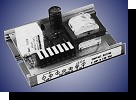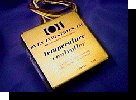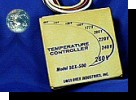Serving OEM and Industrial Customers Since 1964
Temperature Controllers
Descriptive Index - By Model Number
 Legend
Legend
 5C6
Series
5C6
Series
 5C7
& 5R7 Series
5C7
& 5R7 Series
 5CJ
Series
5CJ
Series
 5CK
Series
5CK
Series
 5CX
Series
5CX
Series
|
|
| 5C7 & 5R7 SERIES |
|
| |
|
|
|
5R7-001





 
5R7-002





 

PC
Compatible Thermoelectric
Controller
(TEC): The Models 5R7-001
and 5R7-002
digital temperature controllers
are
all solid state, H-bridge, automatic biphase output controllers. These
are versatile, powerful controllers
that
can power Thermoelectric (Peltier effect, or TEC) modules. The 5R7-001
uses RS232 for communications, and the similar 5R7-002 uses RS485. Optional display.
|
| |
|
 |
5C7-195






Benchtop Temperature Controller:
Selectable
VDC output and a front panel. The 5C7-195
is an enclosed temperature controller that has its own power supply and
selectable DC voltages for the output power (to a TE module,
resistive
heater, or other DC load). The front panel provides access to some of
the
configuration settings. A configuration program running on your PC
provides
access to more of the settings (the controller, however, does not have
to be connected to a computer to run). |
| |
|
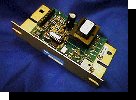 |
5C7-252






Our Low Cost PC
Compatible
Controller is our least expensive PC
Programmable
(PCP), proportional (PID) temperature controller. With its low price,
this
high quality controller is inexpensive enough to be used as a
temperature
sensor/monitor only. It has two thermistor inputs. The controller can
be
configured and monitored from a PC. |
| |
|
|
|
5C7-350
 
 
5C7-350A
 
 

Small, Self-contained Unipolar
Thermoelectric
Controller - The Models 5C7-350 and 5C7-350A are economical, open
board
temperature controllers especially designed to operate with
thermoelectric
(Peltier effect) modules. Most of these modules may be operated in
either
a cooling mode or a heating mode depending on current direction. Self
Contained.
7.5 Amp output. |
| |
|

|
5R7-388








PC Compatible Thermoelectric
Controller Uses Type "T" Thermocouple Sensor: The RoHS Compliant
Model 5R7-388 digital temperature controller is all solid state, H-bridge, automatic biphase output controllers that
uses Type "T" Thermocouples as sensors. This is a versatile, powerful controller
that can power Thermoelectric (Peltier effect, or TEC) modules or other DC loads. The 5R7-388
uses RS232 for communications. Optional display. |
| |
|

|
5R7-570
 
 


Self-contained
Bipolar Thermoelectric Controller - The
Models
5R7-570 and 5R7-570A are economical, open board temperature controllers
especially designed to operate with thermoelectric (Peltier effect)
modules.
Unlike the Model 5C7-350 above, the Model 5R7-570 and 5R7-570A
controllers
will automatically switch between Heating and Cooling modes as
required.
Self Contained. 12.5 Amp output. Optional display. (Previous similar model: 5C7-550(A)) |
| |
|
|
|
5C7-361






5C7-362






5C7-365






5C7-366






5C7-367






5C7-368






5C7-371







5C7-378






5C7-379






5C7-385






5C7-386






5C7-388







Obsolete.
Instead, for RS232 based controllers see the 5R7-001.
For RS485 based controllers see the 5R7-002.
FOr the 5C7-378 we have a RoHS compliant version that is more powerful
and provides better control, ask about the Model 5R7-388.
PC Compatible
Thermoelectric Controller
(TEC)
- The Models
5C7-361 thru 5C7-385 digital temperature controllers
are
all solid state, H-bridge, automatic biphase output controllers. They
have
various input types, output power capabilities, temperature ranges and
temperature sensitivities. These are versatile, powerful controllers
that
can power Thermoelectric (Peltier effect, or TEC) modules. Add a diode
for control of resistive heaters and various DC loads. |
| |
|
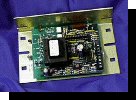 |
5C7-461






PC
CompatibleThermocouple
Based Controller for use with
Thermocouple
Sensors. Proportional (PID) temperature controller. The convenience of
a PC Programmable (PCP) controller, the wide temperature range of
thermocouple
sensors, and the flexibility of the industry standard RS485 interface
means
outstanding performance in a wide variety of applications (use
RS232
with our
"RS485/RS232
converter"). |
| |
|
|
|
|
5C7-582






5R7-583






1KW+ PC
Compatible Thermoelectric
Controller: The Models
5C7-582 and 5R7-583
digital temperature controllers
are
all solid state, H-bridge, automatic biphase output controllers.
These
are versatile, powerful controllers
that
can power Thermoelectric (Peltier effect, or TEC) modules or other DC loads. The 5C7-582
uses RS232 for communications.
The 5C7-582 cn handle 1KW of power. As a server it can control multiple
5R7-583 clients, each handling an additional 900 Watts. Optional display. |
|
TEMPERATURE SENSORS
Ohms@25°C
THERMISTOR SERIES
•
•
•
•
•
•
•
•
•
•
•
RELATED SENSOR PAGES
•
•
•
DESIGN & MANUFACTURING
•
•
With our RS485/RS232 interface you can run any RS485 device off your computer's serial port (the RS232 COM port). Our interface is an opto-isolated "Automatic Transmit-Enable" converter (°3000VDC, 1 second). This device is RS232 to RS485 and back with 9-35VDC single-supply operation, communications status lights, on-board RS485 protection, and other enhancements. Includes enclosure, power supply and RS-232 cable.
Model IHV24AT-B9FSPS
$140.00 QTY1
when purchased with controllers.
$180.00 QTY1 Alone
OEM/QTY pricing is available.
RS232 SERIAL PORT CONNECTION
Usually you connect to the serial port of the computer using
a female DB9 or female DB25 connector. Also referred to as a
female 9 pin, or female 25 pin, D-shell connector. The serial
port is RS232C (or RS-232C). RS232 stands for Recommended
Standard number 232, and the C stands for revision C. Each RS232
device at our site connects to an RS232C serial port through
a cable you provide (unless otherwise noted). 3 wires are generally
used: Signal Ground, Trasmitted Data (TD), and Received Data (RD),
otherwise referred to as Ground, Transmit and Receive. At both
ends of the cable, pin 1 is Ground. At the computer,
Receive is pin 2, while at the peripheral (e.g., temperature controller)
it is pin 3. At the computer,
Transmit is pin 3, while at the peripheral it is pin 2. The connection
is made via "twisted pair" - which
means the Transmit and Receive lines are twisted around each
other along their length, from one end to the other. For the cable, solid copper wire
is preferred over stranded wire simply because there are no strands
at the end that can break off, or bend out, and short the connection. With appropriate
converters you could connect by other means, such as infra-red light (e.g., IrDA).
RS485 Serial Communications
RS485 (Recommended Standard 485) is specified to handle up to 32 devices in one
loop. The "loop" is a length of 2 or 3 wires: +, - and ground. The devices
tap into the wires along their length. The end of the + and - pair of wires
is terminated with a resistor. Modern ICs used as an interface to the loop
can sometimes handle more that 32 devices on one loop. It is sometimes
possible to have 64 or 96 or more devices on the same loop. With RS232/RS485
converters, each loop uses one of the computer's COM ports. Baud rates
greater than 100,000 baud are possible depending on the computer and the
operating system. An edge connector allows you to attach a cable for the
RS-485. 2 wires minimum [A and B, or (+) and (-)] are usually needed but
COMMON is provided as well. Any untwisted wire is fine for a short run,
but best, especially for long runs, is shielded, twisted pair, 120 Ohm
characteristic impedance cable. for more detailed information see our library
document RS-485
Serial Interface.
AMBIENT OPERATING TEMPERATURES
Definition of Ambient Temperature
"The temperature of the atmosphere, liquid, or other medium surrounding an object."
Source: The World Book Dictionary, © 1966 by Doubleday & Company, Inc.
Low Ambient Operating Temperatures
Almost all of our temperature controllers will function at ambient temperatures down to -20ºC (-4ºF).
Many designs will accept a -40ºC (-40ºF) operating ambient. Custom controllers can be built to operate down to -55ºC (-67ºF).
Operation at the low ambient is determined by the ICs used and their ability to have
the correct gain and stable states. The output or load circuit may require
increased drive to turn on. Any design that is specified to a low ambient
operating temperature has been tested and shown to provide sufficient output
drive at that temperature.
High Ambient Operating Temperatures
The high temperature is harder to define than the low, because the high ambient
operating temperature depends upon the controller power dissipation and
the heat sink dissipation.
For all our Pulse Width Modulated (PWM) controllers the following applies:
The power dissipation of the controller is largely a function of the load
current, and only slightly a function of the input voltage. Example: A
unit running at 28v and 25 amps will dissipate the same power into the
base as one which is 12v and 25 amps, however reducing the load current
to 12.5 amps will reduce the power dissipation into the base by 1/2.
For an analog controller, the standard 1/4 power point analysis applies
when determining power dissipation.
Specific Examples
TECC:
The TE controllers are limited by the base plate (mounting bracket) temperature,
because this is the heat sink for the bi-phase H-Bridge. Under full load
the controller will be dissipating approximately 15 watts into the base
plate, Therefore, if the controller is operated at elevated temperatures
you need to provide additional heat sinking for the base plate. At laboratory
temperatures (room temperature, about 20ºC or 70ºF) the controller
will reach about 75ºC under full load. So if you provide an additional
heat sink which results in, say. 70ºC in a 50ºC ambient, the
controller will still function appropriately.
Model 5C6-353: This Laboratory Benchtop Temperature Controller with a 10
Ampere maximum output is designed to run in a laboratory environment. Maximum
ambient operating temperature is 35ºC to 40ºC (95ºF to 104ºF).
Model 5C6-355: This Laboratory Benchtop Temperature Controller with a 15
Ampere maximum output is designed to run in a laboratory environment. Maximum
ambient operating temperature is 30ºC (86ºF).
Model 5CX-140: The 5CX-140 series of controllers have a "derating curve"
(see below) on the customer drawing that is defined by the temperature of the case.
 5CX-140 Series Derating Curve
5CX-140 Series Derating Curve
 5C6
Series
5C6
Series
 5C7
& 5R7 Series
5C7
& 5R7 Series  5CJ
Series
5CJ
Series
 5CK
Series
5CK
Series
 5CX
Series
5CX
Series























































































































































